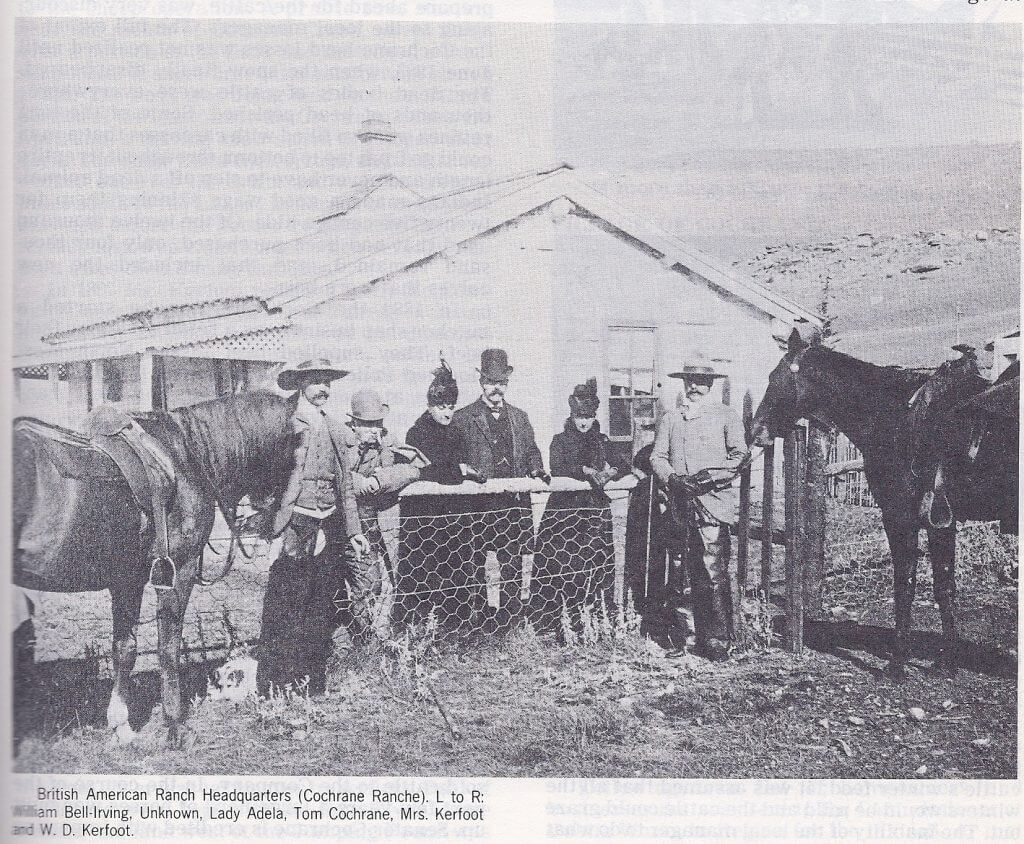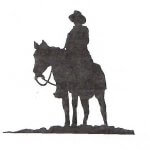Excerpt from D.E. Brown's U. of A. Thesis 1951
In 1872, in an effort to encourage the settlement and development of western lands, the Dominion Government passed the first land act providing for the granting to settlers of the land adjacent to their farms for grazing purposes. This act was broadened in 1876 to allow for the granting of leases to anyone. Tracts of land, generally not in excess of one hundred thousand acres, could be leased by individuals or companies at the rate of one cent per acre per year. In the early history of ranching in southern Alberta, the strongly organized and heavily capitalized ranching companies greatly overshadowed the individually owned ranches.
Generally, English or Eastern Canadian capitalists formed a ranching company, subscribed to the capital investment, took up an extensive lease, purchased a large herd of cattle in the United States to stock the lease and launched a large-scale ranching enterprise in a short time. Individual ranchers, on the other hand, were often hampered by a lack of capital and were forced to expand much more slowly. The great ranching companies gave the industry a tremendous impetus at its very outset and had very soon established an economically sound foundation for the future development of ranching in southern Alberta.
The Cochrane Ranche Company (limited) whose holdings lay in the area under consideration, was the first of these great ranching companies. The Company was incorporated by the Dominion Government on May 14, l88l, although it had been formed sometime earlier. Senator M. H. Cochrane was President and his son, W. F. Cochrane, was manager. The company also included Hugh MacKay, merchant, William Lawrence, manufacturer, William Cassils, Gentleman, William Ewing, seedsman, and Charles Cassils, manufacturer, all of the city of Montreal. It was capitalized at five hundred thousand dollars. Major James Walker, a former North West Mounted Police inspector, was appointed local manager and Dr. D. M. McEachren was made resident general manager.

Tom and Lady Adela Cochrane were neighbours from Mitford and not associated with the Cochrane Ranche.
Senator M. H. Cochrane, its founder, was the driving personality behind the Cochrane Ranche Company. Mathew Henry Cochrane was born at Hillhurst Farm, Compton, Quebec, in 1823. He took an early interest in farming, but at the age of eighteen, he went to Boston and established a leather business. In 1854 he returned to Canada and, in partnership with Cassils and Company of Montreal, opened a boot and shoe factory. By 1888 this business had a gross yearly income of half a million dollars.
It was however as a successful breeder of improved grades of cattle that he was best known. In this respect, his reputation was worldwide. In 1864 he purchased Hillhurst Farm from his father and three years later obtained the services of Simon Beattie, an outstanding judge of cattle, as farm manager and adviser. With the help of Simon Beattie, Mr. Cochrane set out to secure the best Shorthorn cattle that could be bought.
In 1867 he purchased two outstanding animals in Britain – the famous cow “Rosedale”, who had no peer in the English show rings, and ’’Baron Booth of Lancaster”, a bull calf. “Rosedale” attained a greater celebrity than has ever been achieved by any cow on this continent. She was the sensation of every show.
“Baron Booth” subsequently passed into the hands of a cattle breeder in Illinois and his record as a show animal and a sire brought about a revolution in the Shorthorn industry of the United States mid-west.
In 1868, Mr. Cochrane imported the first of the famous “Bates” cattle into Canada. There were eleven head, and one of them, “Duchess 97th”, cost a thousand guineas, the highest price that had ever been paid for a cow. “Duchess 97th” was later sold to a New York breeder for a record seventeen thousand nine hundred dollars. From then on Mr. Cochrane carried on a campaign of importing the best English Shorthorns and selling them on this continent.
There seems to have been no shrewder dealer in Shorthorns during the history of this breed of cattle. In 1882 Senator Cochrane abandoned the breeding of Shorthorns for a time and went into Aberdeen-Angus and Hereford cattle, importing some of the finest specimens of these breeds then available. He also imported choice lots of Southdown, Cotswold, Leicester and Lincoln sheep. A number of excellent Suffolk horses and Berkshire pigs were also brought to Canada. Senator Cochrane’s contribution to the improvement of Canadian, and United States, livestock cannot be overestimated. He had the courage, and the money, to buy the best animals.
He was a pioneer in this field and his purchases made available to this continent’s livestock breeders the finest breeding stock of the period. He was called to the Senate in October 1872. Besides his interests in livestock, the boot and shoe factory and the Cochrane ranch, he was a vice president of the Eastern Townships Bank, a governor of the Sherbrooke Protestant Hospital, a trustee of Bishop*s College, Lennoxville, and a member of the Council of Agriculture in Quebec, Senator Cochrane died in 1903.
I'd always assumed that since the cattle operations of the Cochrane Ranche was so short, it was due to the inexperience of the owners. Not entirely true. Cochrane had considerable experience in different conditions.
Mark Boothby - nephew of D.E. Brown Tweet
There seems to have been no shrewder dealer in Shorthorns during the history of this breed of cattle. In 1882 Senator Cochrane abandoned the breeding of Shorthorns for a time and went into Aberdeen-Angus and Hereford cattle, importing some of the finest specimens of these breeds then available. He also imported choice lots of Southdown, Cotswold, Leicester and Lincoln sheep. A number of excellent Suffolk horses and Berkshire pigs were also brought to Canada. Senator Cochrane’s contribution to the improvement of Canadian, and United States, livestock cannot be overestimated. He had the courage, and the money, to buy the best animals.
He was a pioneer in this field and his purchases made available to this continent’s livestock breeders the finest breeding stock of the period. He was called to the Senate in October 1872. Besides his interests in livestock, the boot and shoe factory and the Cochrane ranch, he was a vice president of the Eastern Townships Bank, a governor of the Sherbrooke Protestant Hospital, a trustee of Bishop*s College, Lennoxville, and a member of the Council of Agriculture in Quebec, Senator Cochrane died in 1903
The only original Cochrane Ranche buildings are the house and barn against the rock face on the hill-side.



